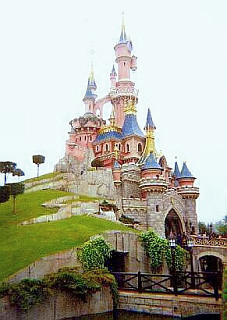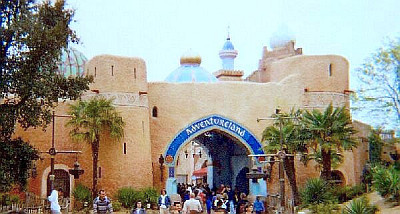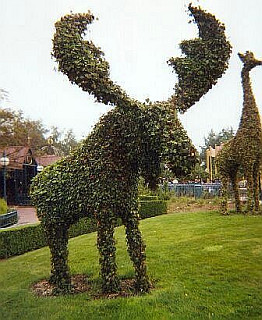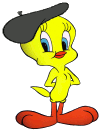
Ile-de-France
Ile-de-France (except Paris)![[Unesco]](/images/unesco-logo.gif)
![[+]](/images/icone-etoile.png)
Ile-de-France is the region including Paris, its inner suburbs (Val-de-Marne, Haut-de-Seine and Seine-Saint-Denis ) and its outer suburbs (Seine-et-Marne, Essonne Val d'Oise and Yvelines). Specific pages are created for Paris and Disneyland, but below, I present other major places visited during my journey : Versailles, Fontainebleau, Vaux- le-Vicomte, Provins, Evry, Saint- Denis, Chantilly.
Versailles
Versailles is a masterpiece wanted by Louis XIV, the Sun King. He commended the expansion of the former hunting lodge to architects, interior designers and landscapers who made Vaux-le-Vicomte, respectively Le Vau for architecture, Le Brun for decoration and Le Nôtre for the gardens.
The castle

After passing the imposing gate, we come to the equestrian statue of Louis XIV, before reaching the entrance to the castle.
The interior is decorated with marble and has nearly 300 apartments. The highlight of the visit is the hall of mirrors created by Le Brun : 17 windows face 17 mirrors on the opposite wall, on a length of 73 m (80 yards). Just a little history to mention that it is in this hall that the Treaty of Versailles was signed in 1919 imposing the conditions of peace with Germany at the end of World War I.
We also see many paintings such as the representation of Louis XIV and the coronation of Napoleon Ist.
The gardens
The gardens designed by Le Nôtre became the benchmark for all European monarchs. At Versailles, the gardens are composed of an orangery, basins with ancient style statues, geometrical gardens (French gardens), a colonnade, a large channel and two palaces : the Petit Trianon and the Grand Trianon.
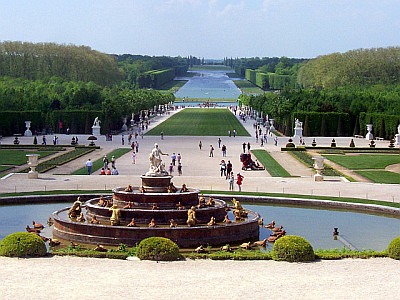
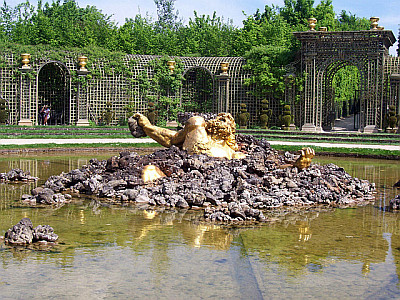
The Hamlet of Queen Marie-Antoinette
Marie-Antoinette liked to go here to find serenity and tranquility.
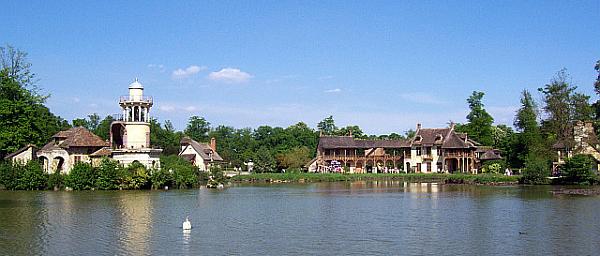
There are some animals : goats, cows, horses, donkeys, chickens, swans... and also many fishes that gather under the bridge leading to the hamlet in order to get a piece of bread thrown by a visitor... For couples, a photo in front of the temple of love is unmissable !
Fontainebleau
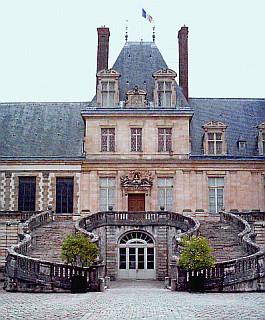
Its name comes from "fontaine belle eau" (beautiful water fountain) which designated the source that feeds the city. There was already a royal residence for hunting in the Middle Ages. The great forest now covers an area of 25,000 ha (61,775 acres).
Most of the present palace of Fontainebleau date back to the 16th century, during the reign of Francis I, who wished to comply with the Florentine Renaissance.
Henri IV enlarged it by choosing instead a Flemish-inspired style. Louis XIII, Louis XIV and Napoleon Bonaparte also brought their touch. The result is a succession of different styles. There are four courtyards (white horse court, fountain court, oval court and Henri IV court), which largest and main courtyard is white horse court, and three gardens (Diana garden, English garden and grand parterre).
White horse court
White horse court (thus named because there was formerly an equestrian statue of Marcus Aurelius) is also called farewell court since Napoleon had made his farewells to his soldiers before leaving in exile to the island of Elba in 1814.
The extravagant horseshoe staircase dates back to 1634 (Louis XIII). A passage for carriages was built under it.
Golden gate
The previous grand entrance under Francis Ist kept the animal symbol of the latter : the salamander (which rather looks like a dragon here).
Nearby, in fountain court, we can see the monogram H (for Henri IV) flanked by two cornucopias.
The gardens
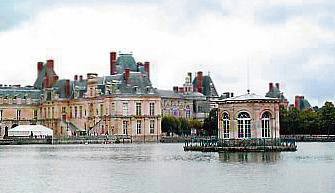
The grand parterre designed by Le Nôtre is the largest in Europe.
From the English garden, near the entrance gate, one can see a grotto behind arcades with bosses and atlants.
Facing fountain court, there is a large pond called carp pond with a nice pavilion.
"Grands appartements" (great apartments)
Among the rooms we can visit, here are the most noticeable :
- Francis Ist gallery, made up of allegorical frescoes and stucco. Stucco is an imitation of marble made from plaster, glue and pigments, and carried out by skilled workers. The exact meaning of the gallery could not be established for sure.
- The magnificent renaissance ballroom with its coffered ceiling decorated with gold and silver.
- The long library.
- The Queen's chamber.
- Among the most beautiful rooms, there is also the Royal chamber moved into the throne room and the chapel of the Trinity.
More
The visit of the "petits appartements" (small apartments) of Napoleon Ist and Napoleon Ist museum can be a complement to the Royal apartments.
Vaux-le-Vicomte
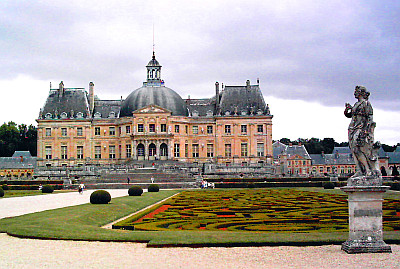
This castle is a little gem, but it caused the misfortune of its owner !
Nicolas Fouquet was the young superintendent of Finance of Louis XIV. The symbol of his family was the squirrel, chosen for its ability to climb to the peaks. Quickly rich, he built a castle in Vaux involving three great artists : Louis Le Vau for architecture, Charles Le Brun for decoration and André Le Nôtre for the gardens. This castle proves the taste and refinement of Fouquet, who had also great friends among scholars including Jean De La Fontaine.
Envied first by Colbert, one of his political rivals, he will also soon be envied by Louis XIV after a visit to Vaux-le-Vicomte ! The splendor of the castle was beyond the one of king's castle, and it was unbearable to the king. Later on, Louis XIV will also ask the same artists to work on Versailles castle : Le Vau, Le Brun, and Le Nôtre... But before, unscrupulous and with slander, he put Fouquet on trial for treason. Fouquet, who had many support (including his friend La Fontaine), was convicted by the courts to banishment for life, but the "Sun King", encouraged by Colbert, switched the penalty to life imprisonment !
The musketeer who arrested Fouquet was named D'Artagnan and inspired Alexandre Dumas for the name for the hero of his famous novel "The Three Musketeers".
Fouquet was imprisoned in Pinerolo, the same prison as the one of the "iron mask", a mysterious prisoner who wore a leather mask and remained unknown. In fact, despite many rumors and assumptions, the "iron mask" was neither Fouquet nor the twin brother of Louis XIV but probably a jack forced to wear that mask by the jailer of Pinerolo, the Marquis de Saint-Mars, who thus had people believed he was holding a prisoner of great importance. But that will not explain why Louis XVIII told he knew the secret but could not reveal it to save the honor of his grandfather Louis XIV... Was there anything else ?
After visiting the castle we can visit the carriage museum.
Provins, "the city of roses"
The former capital of the Counts of Champagne was an important medieval fair town during the 12th and 13th century, with the cities of Troyes and Chalons-en-Champagne. The counts of Champagne were the first to carry out a safe-conduct for escort of soldiers accompanying the merchants. This guarantee helped the fairs of the city to grow and become the largest in Europe. Ditto for the city which became then a major financial center. The merchants came from north (Flanders), South (Italy), and East. Poets and writers could also be met during fairs such as Chrétien de Troyes. With the rise of trade routes (routes of the Alps, crossing of the strait of Gibraltar) and the abolition of the privileges of the merchants that resulted in the disappearance of fairs in a few decades, Provins falls into isolation in the 14th century. But this is why it has been preserved.
Brought from the Crusades by Thibaud de Champagne in 1240, the rose of Provins is a symbol of the city with Caesar's tower. As a matter of fact, the rose has remained a specialty of the city.
You have to go in the upper town (the medieval city) where you can visit the key monuments of the city and attend events including the "Eagles of the ramparts". You can request a map of the city to the tourist office near the car park of the upper town.
Caesar's tower
The original tower of the 12th century was changed in the 16th and 17th century. It is the only known example of octagonal tower with a square base and it has become a symbol of the city.
The ramparts
The city has kept much of its walls on which it is possible to walk. From there, one can get a nice view over the countryside (the Brie).
The tithe barn
This is an old three-story market hall which was rented to the merchants during fairs. The basement was used to store the goods. The ground floor was the store while the first floor contained the homes. The rooms are built with cross-ribbed vaults. With the decline of the fairs, the building was then converted into a warehouse to tithes (fees paid to the church) taken on farmers' crops. It now houses an exhibition about merchants and fairs of that time. Among the characters, we find :
- the Italian merchant sold products from Mediterranean or East : silk, spices... He contributed to trade by buying products from Northern Europe and selling them once back in Italy.
- the Flemish merchants sold wool, furs and skins from northern Europe (England, Poland...) and even wine of Bordeaux. Actually Bordeaux was then linked to England and wine first transited by that country, then from England to Flanders and finally from Flanders to France via fairs !
- the merchants of Provins were specialized in sheets.
- the money changer changed currencies in Champenois denier. It was forbidden by the church to Christians changers to make a profit on the money but they could take interest if the merchant had made capital gains. Jew changers did not have the same restriction and could take directly some interests on the exchange. The counts of Champagne took their part too by imposing a levy. The coins to change were first weighed with a balance to differentiate correct coins from bad coins. The bill of exchange was already used to facilitate trade.
- The public scribe wrote the bills of exchange as well as all transactions between merchants and money changers.
- Many other businesses had grown with the fairs : wool craftsmen, potters, quarry-workers (extraction of the stone sold to tanners...), stonemasons (who left their distinctive mark on cut stones, to be sure of being paid), parchment makers (the scrolls were made from the skin of sheep after passing through hot water baths and cutting of the wool)...
Saint-Quiriace church
Its construction began in the 12th century but it has never been completed. The dome was added in the 17th century.
Underground galleries
Their function has not been formally established but the most likely hypothesis is that they were created to extract the stone required for pressing sheets, a specialty of Provins in the Middle Ages. This network would have first been used as a refuge and a warehouse and then as a meeting place for freemasons. The walls are decorated with many graffitis from the 18th and 19th century.
Provinois museum
This museum is a good idea to draw out the visit.
The city in the Middle Ages
We see stone houses and half-timbered houses : a medieval heritage. The half-timbered houses were easy to build. Once the wood framing done, the cob (a mixture of water, clay, sand and straw) was applied to fill the spaces between sections. Cob was thus an economical material but with good insulating properties. The finishing phase was to coat the vertical surfaces of quicklime. Note that in many regions, half-timbered houses were forbidden in favor of brick houses much less flammable.
Shows
The city has become attractive by the organization of medieval shows.
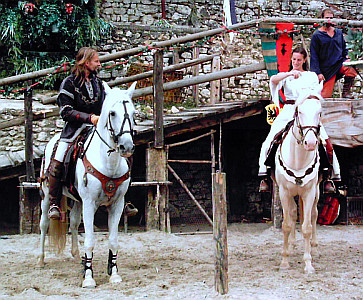
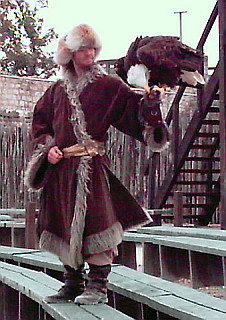
I particularly enjoyed the show "Eagles of the ramparts" where eagles, nozzles and other vultures brush past the people with their wings : the show is good and the many flights of raptors (hawks, eagles, vultures, owls...) are memorable ! We can also visit the aviaries.
Raptors are characterized by a very good view and a great agility in the air.
Here are below some wingspans :
Condor : 2.90 m (3.20 yards)
Bearded vulture : 2.50 m (2.75 yards)
Secretary bird : 2.10 m (2.30 yards)
Osprey from asia : 2 m (2.20 yards)
Rough-legged hawk : 1,50 m (1.65 yards)
Peregrine : 1 m (1.10 yards)
Kestrel : 0,70 m (0.75 yards)
Little hawk : 0,40 m (0.45 yards)
Let's compare it with a man with outstretched arms : 1.70 m (1.85 yards)
In the show of chivalry, the "legend of the Knights", Thibaud IV had come back from crusades and had to release his bride, the beautiful Blanche, from a spell launched by the dark Morvak ! The confrontation between the two men is inevitable. And it was Thibaud IV who took over : all is well that ends well !
More visits
There are more monuments (St. Ayoul church, Notre-Dame-du-Val Tower, Sainte-Croix Church...) that can be visited in the lower town.
Evry cathedral
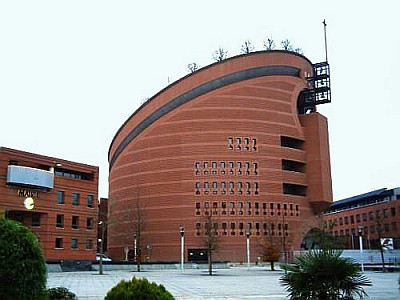
Evry is a new town created to relieve Paris (another new city is also being created to Sénart). Too bad that the city suffers from delinquency in the evening, but the cathedral is outstanding : it is built in an atypical modern style. It is the only modern cathedral to be built in France in the 20th century.
Saint-Denis
Saint Denis was the first bishop of Paris. He died martyred in the mid-third century. The legend says that after his beheading on Montmartre, he took his head in his arms and started walking to the north of Paris to the place where he would be buried... Nowadays, the surroundings of Saint-Denis are not the safest places in the Paris suburds, but there is no reason not to go and visit the basilica...
Saint-Denis basilica
A church was built around 450-475 on the burial place of St. Denis at the request of St. Genevieve, the patron saint of Paris (who saved the city from Attila's Huns by her prayers). It was enlarged in the 6th century and the 7th century under Dagobert I who demanded to be buried there to rest alongside the body of the saint. Since then, the church became the necropolis of the kings of France whatever their dynasty (Merovingian, Carolingian, Capetian, Valois and Bourbon). Note that all the kings of France are not necessarily buried in Saint-Denis, but the majority of them...
The current basilica was built in the 12th century on the site of the first church. It was desecrated in 1793 by the revolutionary who exhumed many graves and threw the bodies and ashes in common graves. The lost head of King Henry IV would have been found again in 2008. That mummified head (kings were embalmed) has been the subject of many scientific investigations. But as often, there are pros and cons...
Despite the damage, the basilica still houses the tombs and mausoleums of several kings of France, surmounted by recumbent statues. As the graves are empty, they are called cenotaphs. These tombs are remarkable.
The dog at the foot of his/her master symbolizes loyalty.
The lying statue of the deceased naked under a shroud symbolizes the passage to the afterlife. There are also praying statues.
Count Bertrand du Guesclin, Constable of France and instigator of the guerrilla war against the English troops during the Hundred Years War was the predecessor of Joan of Arc. He died in Châteauneuf-de-Randon, Lozère, after drinking water too cold. He was buried in Saint-Denis with the kings of France (a rare privilege). His tomb was also desecrated by the revolutionary.
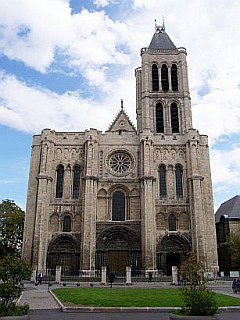
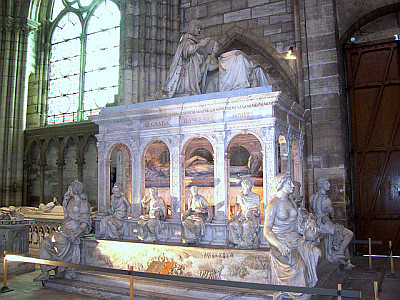
Although the coronation of the Kings of France was held in Reims, the abbot of Saint-Denis was the keeper of the royal insignia. Thus, in one of the chapels, we can see the objects of the coronation called regalia.
We also can see a statue of St. Denis, carved with his head levitating.
The stade de France
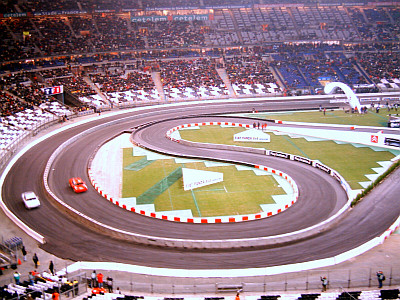
It was built for the World Cup of football in 1998, won by France in a memorable final against Brazil.
Not being a big fan of football, I decided to go there for the car show "the race of champions" : we can do anything in the stade de France !... We can also visit it off match. It's a stadium with a nice view over the pitch and a good lighting.
Argenteuil
The Holy Coat is kept in the Basilica of Argenteuil : it is a seamless robe stained with blood that would have been worn by Christ.
Indeed, at the death of a crucified, the Roman soldiers could share his clothes. It would be during the 4th century that St. Helena, mother of Emperor Constantine, would have found it and then kept at Constantinople. In 800, the Empress Irene of Byzantium offered it to the Emperor Charlemagne, who gives it to his daughter Théodrade, prioress of a convent in Argenteuil.
During the Terror in 1793, the priest of the city cut it into three pieces and hid each one of them. In 1795, the two pieces found were sewn together.
Note : a carbon-14 dating in 2003 dated the Holy Coat to the 6th century but there are discrepencies about that result as the tunic was manipulated a lot and was even buried.
Nowadays, the tunic is "hidden" in its reliquary.
Chantilly, "the horse capital of France"
Destroyed during the Revolution, the castle was rebuilt in the 19th century in a Renaissance style. It houses collections of art.
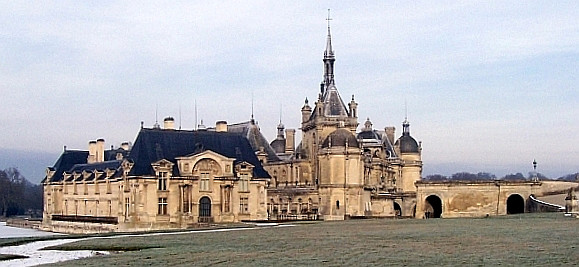
The living museum of the horse is now in the stables. Horse shows are held in December (see http://www.domainedechantilly.com/index_va.php).
We can have a long walk in the large park in the forest. Be careful outside the domain because boars are present in the forest and we can sometimes see some of them near the roadway : so drive cautiously.
Parc Astérix
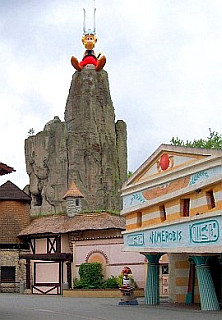
A little more than a kilometer (nearly a mile) from Chantilly, we can go to the amusement park nearby : the parc Astérix. "Tonnerre de Zeus" (thunder of Zeus) is one of its top attractions.
Disneyland resort Paris
The Disney theme park in Europe is located in Marne-la-Vallee, southeast of Paris. There are many attractions and nice decors. To allow a complete visit (on two days) and to welcome visitors who come from far, hotels have been created directly on the site. We can visit Disneyland, but also the Walt Disney Studios.
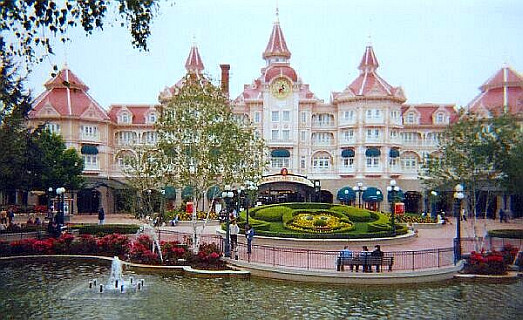
In Disneyland, you can start with a train ride before moving to the attractions including : the maze of Alice in Wonderland, cups of Wonderland, the land of fairy tales, the haunted house (with holograms !), space mountain, pirates of the Caribbean...
The decors also contribute to the success of the park, especially the castle of Sleeping Beauty (coming closer, we can discover the dragon's lair...), the city of Aladdin,... and also nice decorative hedges in the paths.
